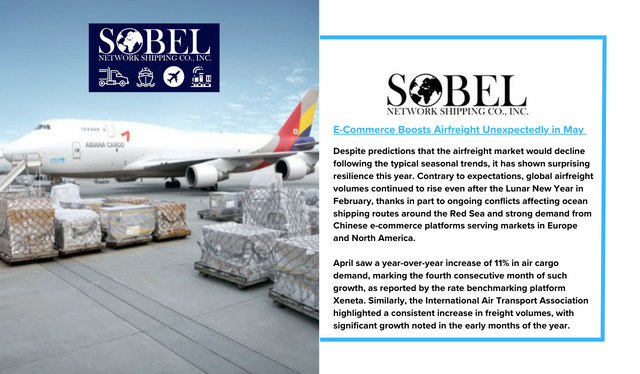Despite predictions that the airfreight market would decline following the typical seasonal trends, it has shown surprising resilience this year. Contrary to expectations, global airfreight volumes continued to rise even after the Lunar New Year in February, thanks in part to ongoing conflicts affecting ocean shipping routes around the Red Sea and strong demand from Chinese e-commerce platforms serving markets in Europe and North America.
April saw a year-over-year increase of 11% in air cargo demand, marking the fourth consecutive month of such growth, as reported by the rate benchmarking platform Xeneta. Similarly, the International Air Transport Association highlighted a consistent increase in freight volumes, with significant growth noted in the early months of the year.
Early May continued this trend with a 12% to 16% increase in volumes, reflecting ongoing robust demand. Although there has been a slight decrease in demand from the Indian subcontinent and Southeast Asia due to more predictable ocean shipping schedules, overall volumes remain substantially higher than historical averages. Events like the Muslim Eid holiday and incidents such as flooding at Dubai airport only momentarily dampened the growth, which quickly resumed with strong shipments of flowers from Central and South America, primarily destined for North America.
Cargo revenues for airlines in the first quarter show an improvement over the previous year, with narrower declines compared to the steep drops in 2022. Spot rates for air cargo are now aligning with last year’s figures for the first time since August 2022, and cargo capacity has seen a 5% year-over-year increase as airlines deploy more aircraft for summer schedules.
The Asia-Pacific region, in particular, continues to exhibit strong export volumes. Despite a post-Lunar New Year dip, rates have significantly recovered, particularly on routes from northeast Asia to the U.S. Additionally, airfreight rates from the Middle East and southwest Asia have surged due to prolonged ocean transit times around Africa.
Despite some stabilization in the airfreight market due to longer planning horizons for ocean routes to Europe, volumes from the Middle East and the Indian subcontinent remain high, appealing to those seeking faster alternatives to ocean freight. The rerouting of shipping around the Horn of Africa and increased demand in Europe have led to congestion and capacity shortages in maritime transport, affecting the availability and pricing of container shipping.
The dynamic nature of global logistics continues to affect freight rates and capacities across modes of transport. While sea freight faces challenges, air cargo remains a critical and resilient component of global trade, driven by diverse and evolving demand sources such as e-commerce and strategic rerouting due to geopolitical factors.


